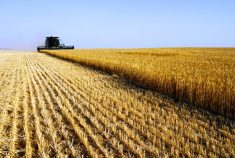After an excruciatingly slow start to the seeding season, Prairie farmers are quickly getting the crop into the ground, according to the latest crop reports from the agriculture departments of all three provincial governments.
In Alberta, weather conditions in the province during the last two weeks have been mainly warm, windy and dry, although some isolated light precipitation has been reported in a few areas. This has helped producers to make significant seeding progress during the past two weeks.
As of May 21, nearly 66 per cent of the province has been seeded, compared to three per cent two weeks ago. This is on par with the 5-year average. Seeding is most advanced in the south region, with close to 88 per cent completed, followed by the central region (over 69 per cent), northwest (56 per cent), northeast (52 per cent), and Peace region (43 per cent).
Read Also

Brazil to reap record soy crop in 2025/2026, increase exports
Brazil’s Conab said the country will reap a record soybean crop of 177.6 million tons in the 2025/2026 harvest year, according to data released on Thursday.
Soil moisture conditions vary across the province. Provincially, surface soil moisture is rated as five per cent poor, 20 per cent fair, 47 per cent good, 25 per cent excellent, and three per cent excessive. Sub-surface moisture is rated as three per cent poor, 19 per cent fair, 46 per cent good, 31 per cent excellent, and one per cent excessive.
Warm, windy conditions, coupled with the lack of rainfall, have depleted much of the surface soil moisture in some areas of the province, particularly in the northern, central and southern regions. These areas will need rain in the upcoming week. However, on the flipside, dry conditions have been beneficial for producers in the northern part of the province who were experiencing wet conditions early in the season.
Tame hay and pasture are showing good growth in most areas of the province. Provincially, pasture conditions are reported as three per cent poor, 21 per cent fair, 50 per cent good, and 26 per cent excellent, while tame hay growth is rated as three per cent poor, 20 per cent fair, 50 per cent good and 27 per cent excellent.
In Saskatchewan, significant seeding progress has been made, according to Saskatchewan Agriculture’s weekly crop report released May 21. Twenty-seven per cent of the 2013 crop is now seeded, compared to eight per cent last week. The five-year (2008-2012) average for this time of year is approximately 44 per cent seeded.
Seeding advanced in all regions of Saskatchewan: 22 per cent of the crop is seeded in the southeast; 51 per cent in the southwest; six per cent in the northeast; 22 per cent in the northwest; 22 per cent in the east-central area; and 29 per cent in the west-central area.
Across Saskatchewan, 52 per cent of field peas have been seeded; 46 per cent of lentils; 40 per cent of durum; 27 per cent of spring wheat; 23 per cent of canola; 20 per cent of mustard; 19 per cent of chickpeas; 12 per cent of barley; six per cent of flax; and four per cent of canary seed.
Precipitation this week ranged from trace amounts to more than two inches in the southeast region. Topsoil moisture on cropland is rated as 14 per cent surplus, 78 per cent adequate and eight per cent short. Hay land and pasture topsoil moisture is rated as seven per cent surplus, 78 per cent adequate, 14 per cent short and one per cent very short.
Producers also made good seeding progress over the past week in many areas of Manitoba. Seeding is estimated to be 75-80 per cent complete in the southwest, 80 per cent complete in the northwest, 70-85 per cent complete in the central region, 85 per cent complete in the east and 75-80 per cent complete in the Interlake region.
In areas that received higher amounts of precipitation, seeding progress is not as advanced. Many producers are modifying their initial seeding plans to account for seeding date, particularly with long season crops such as grain corn and soybeans.
The earliest seeded crops are emerging; growth is slow due to cooler conditions. Re-seeding of winter wheat is occurring throughout the province due to poor plant stands. Pasture and hay growth continues to improve but growth is slow due to the continuing cool spring weather and wet conditions in some areas. — AGCanada.com Network













